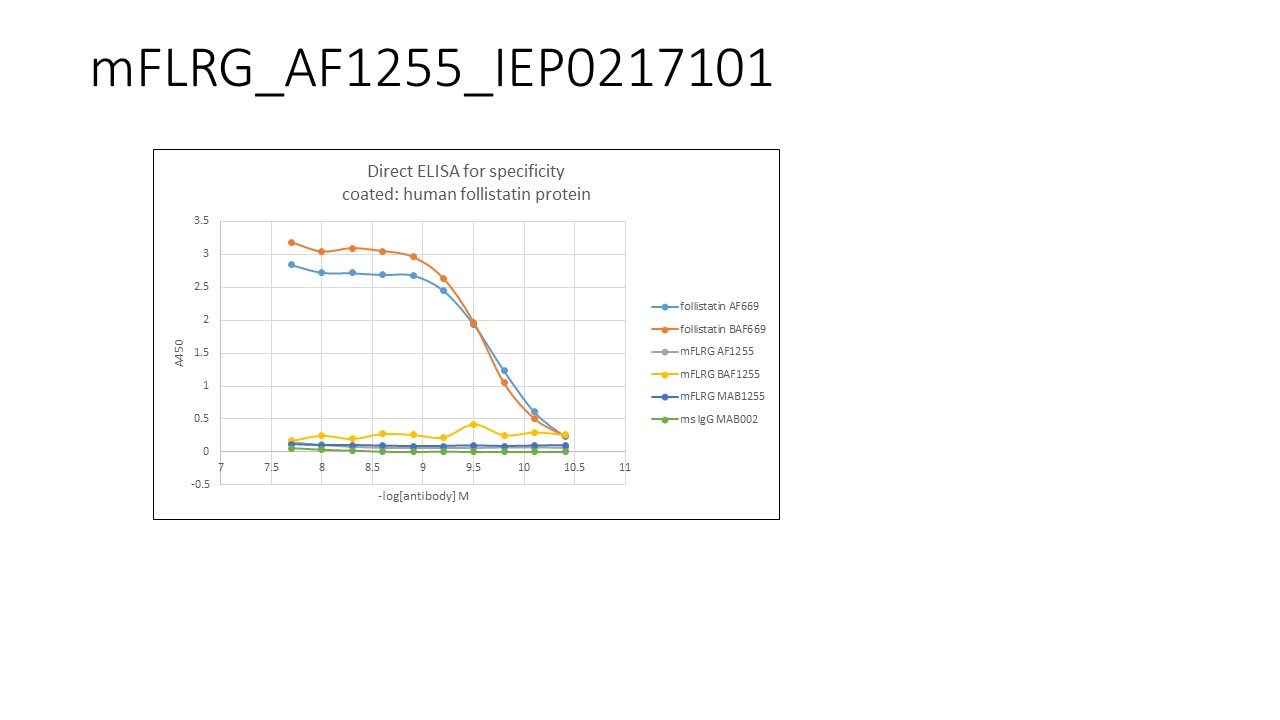Mouse Follistatin-related Gene Protein/
FLRG Antibody
Mouse Follistatin-related Gene Protein/
FLRG Antibody Summary
Val24-Val256
Accession # Q9EQC7
Applications
Please Note: Optimal dilutions should be determined by each laboratory for each application. General Protocols are available in the Technical Information section on our website.
Scientific Data
 View Larger
View Larger
Follistatin-related Gene Protein/FLRG Inhibition of Activin A-induced Hemoglobin Expression and Neutralization by Mouse Follistatin-related Gene Protein/FLRG Antibody. Recombinant Mouse Follistatin-related Gene Protein/FLRG (Catalog # 1255-F3) inhibits Recombinant Human/Mouse/Rat Activin A (Catalog # 338-AC) induced hemoglobin expression in the K562 human chronic myelogenous leukemia cell line in a dose-dependent manner (orange line), as measured by the psuedoperoxidase assay. Inhibition of Recombinant Human/Mouse/Rat Activin A (7.5 ng/mL) activity elicited by Recombinant Mouse Follistatin-related Gene Protein/FLRG (0.1 µg/mL) is neutralized (green line) by increasing concentrations of Goat Anti-Mouse Follistatin-related Gene Protein/FLRG Antigen Affinity-purified Polyclonal Antibody (Catalog # AF1255). The ND50 is typically 3-12 µg/mL.
Reconstitution Calculator
Preparation and Storage
- 12 months from date of receipt, -20 to -70 °C as supplied.
- 1 month, 2 to 8 °C under sterile conditions after reconstitution.
- 6 months, -20 to -70 °C under sterile conditions after reconstitution.
Background: Follistatin-related Gene Protein/FLRG
Follistatin-Related Gene Protein (FLRG), also known as follistatin-like 3 (FSTL3) is a glycoprotein belonging to the follistatin-module protein family. Mouse FLRG cDNA encodes a 256 amino acid (aa) residue protein with a putative 23 aa signal peptide, an N-terminal domain, two cysteine-rich follistatin-like domains (FS) and a C‑terminal acidic domain. Compared to follistatin, FLRG lacks the third FS domain found in follistatin. In addition, FLRG also lacks the heparin-binding domain found within the first amino-terminal FS domain of follistatin. Mouse and human FLRG share approximately 83% aa sequence homology. Like follistatin, FLRG has been shown to bind and inhibit the activities of TGF-beta family ligands including activin, BMP-2, -6, -7 and GDF-8/myostatin. While both FLRG and follistatin are located in a wide and overlapping range of adult and fetal tissue, their sites of peak expression differ: FLRG most highly in heart, lung, kidney, placenta and testis, while follistatin is highest in ovary and pituitary. The expression of FLRG is upregulated by TGF-beta and activin signaling through Smad proteins. Although FLRG is a secreted protein in many cell types, it has also been localized to the nuclear compartment in HeLa, 293 and CHO cells (1‑5).
- Tsuchida, K. et al. (2000) J. Biol. Chem. 275:40778.
- Sidis, Y. et al. (2002) Endocrinology 143:1613.
- Tortoriello, D.V. et al. (2001) Endocrinology 142:3426.
- Hill, J. et al. (2002) J. Biol. Chem. 277:40735.
- Bartholin, L. et al. (2001) Oncogene 20:5409.
Product Datasheets
FAQs
No product specific FAQs exist for this product, however you may
View all Antibody FAQsReviews for Mouse Follistatin-related Gene Protein/
FLRG Antibody
Average Rating: 5 (Based on 1 Review)
Have you used Mouse Follistatin-related Gene Protein/
FLRG Antibody?
Submit a review and receive an Amazon gift card.
$25/€18/£15/$25CAN/¥75 Yuan/¥2500 Yen for a review with an image
$10/€7/£6/$10 CAD/¥70 Yuan/¥1110 Yen for a review without an image
Filter by:

